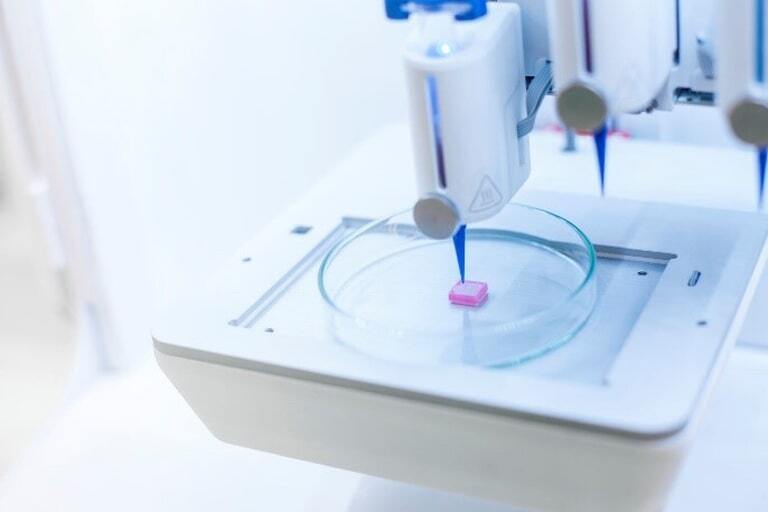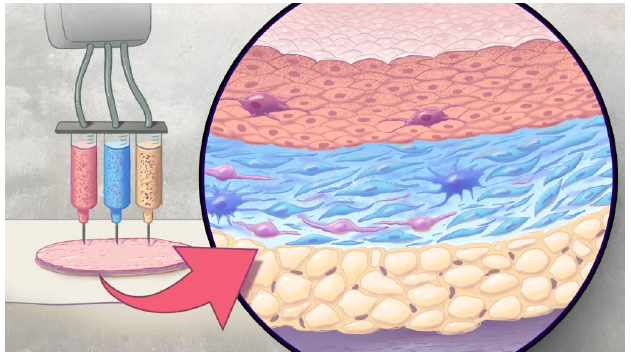How 3D Bioprinting is Revolutionizing Medicine and Tissue Engineering
Introduction and Process of 3D Bioprinting
3D bioprinting is a breakthrough technology that is increasingly being used in medicine and tissue engineering. The process involves creating three-dimensional biological structures by layering cells and biomaterials using computer-controlled printing devices. This makes it possible to create tissues and organs with complex structure and function, which is extremely important in the context of transplantation and the treatment of chronic diseases. In this article, we will take a detailed look at various aspects of 3D bioprinting, including its applications, advantages, disadvantages and future development directions.
3D bioprinting is a complex process that requires precise planning and execution to create functional tissues. The process can be divided into several key steps, each of which plays an important role in achieving the final goal.

Figure 1: Example of a print image [1].
3D Model Design
The first step in 3D bioprinting is to design a 3D model of the tissue to be printed. This model is usually based on data obtained from medical imaging, such as MRI (magnetic resonance imaging) or CT (computed tomography). This data is processed using specialized CAD (Computer-Aided Design) software, which enables the tissue structure to be accurately represented in digital form.
Selection and Preparation of Bioinks
The appropriate bioinks are then selected to be used for printing. Bioinks consist of biomaterials and living cells. Biomaterials can include hydrogels, collagen, alginates and other substances that provide a suitable environment for the cells. Preparation of the bioinks involves mixing the cells with the biomaterials so that the cells are evenly distributed throughout the material.
Calibration and Printing
Before printing, the 3D printer must be properly calibrated. This includes setting printing parameters such as temperature, print speed and nozzle pressure. Calibration is crucial to ensure that the bioink layers are applied accurately and the print quality is achieved.
 Figure 2: Schematic showing the process of myocardial scaffold formation by the bioprinting method. [2]
Figure 2: Schematic showing the process of myocardial scaffold formation by the bioprinting method. [2]
Applications of 3D Bioprinting in Medicine
Biodruk 3D znajduje szerokie zastosowanie w różnych dziedzinach medycyny. Przykłady obejmują leczenie oparzeń i ran, tworzenie implantów kostnych i chrzęstnych oraz biodrukowanie organów.
Treatment of Burns and Wounds
One area where 3D bioprinting can play a significant role is in the treatment of burns and wounds. Currently, skin grafts are often used in cases of severe burns. These grafts can come from another part of the patient’s body (autograft) or from a donor (allograft), a process that is painful and requires a long recovery period. Skin bioprinting makes it possible to create grafts that are precisely matched to the patient, reducing the risk of rejection and speeding up the healing process.
 Figure 3. Schematic representation of the process of creating printed artificial skin by layering specific cellular mixtures to mimic human skin (epidermis (top), dermis (middle) and subcutaneous tissue (bottom)) [3]
Figure 3. Schematic representation of the process of creating printed artificial skin by layering specific cellular mixtures to mimic human skin (epidermis (top), dermis (middle) and subcutaneous tissue (bottom)) [3]
Bone Implants
Bone fractures and bone defects are usually treated by setting and stabilizing with screws, plates or metal implants. In cases of severe bone loss, donor bone grafts or synthetic substitutes can be used. Bioprinting bone implants that are precisely matched to the patient’s anatomy can improve surgical outcomes and shorten recovery time.
Bioprinting of the Organ
Leading research institutes, such as the Wake Forest Institute for Regenerative Medicine, are working to bioprint fully functional organs such as the liver, kidneys and heart. While it may still take some time to fully realize these projects, the first steps toward bioprinting simpler structures such as cartilage and skin are already apparent.
Challenges and the Future of 3D Bioprinting
Technological Challenges
The 3D bioprinting process requires precise control over many parameters, including the quality of the bioinks, the printing and incubation conditions, and the integration of different cell types. Each of these elements must be finely tuned to achieve functional and stable structures.
Biocompatibility and Stability
Biocompatibility and stability of materials used in bioprinting are other challenges. These materials must be biocompatible so that they do not cause immune reactions when implanted into the body. In addition, the structures must be mechanically and functionally stable over a long period of time, which presents additional challenges. Inadequate properties of biomaterials can lead to degradation, which in turn can cause serious health complications.
Vascularization
One of the most serious challenges in 3D bioprinting is vascularization, or the creation of a vascular network in printed tissues. The vascular network is essential for delivering oxygen and nutrients to cells, which is crucial for their survival and function. Current technologies still have limitations in creating effective vascular networks in large structures. Without proper vascularization, printed tissues are unable to function for extended periods of time.
The Future of 3D Bioprinting
The future of 3D bioprinting seems promising, with many new directions for research and development. The integration of bioprinting with other technologies, such as genetic engineering, artificial intelligence and microfuidics, could open up new opportunities in regenerative and personalized medicine. For example, the use of artificial intelligence can speed up the process of bioink design and optimization, and microfuidics can help create more complex vascular structures.
Further advances in bioinks and printing techniques are expected to create increasingly complex and functional tissues and organs. As the technology develops, it will be possible to create tissues of even greater complexity that can be used to treat increasingly complex conditions. In addition, 3D bioprinting may find applications in other fields, such as cosmetology, pharmaceuticals and even food production.
3D bioprinting technology, although still in development, promises to revolutionize many aspects of modern medicine, the food industry and even ecology. The future of 3D bioprinting looks promising, and researchers and engineers around the world are working hard to improve it and expand its applications.
Summary
3D bioprinting is a technology that has the potential to revolutionize many areas of medicine and tissue engineering. From treating burns and creating bone implants to bioprinting organs, the possibilities are almost endless. Despite numerous technological and biological challenges, the future of 3D bioprinting seems extremely promising, and advances in this field could bring significant benefits to patients around the world. Further research and development is crucial to realize the full potential of this innovative technology.
Fryderyk Gajdzik
Źródła:
[1] Sygnis
[2] Jennifer A. Lewis, Byungki Ahn, Sheng Xu, Joseph T. Muth, Peter G. Dixon, Svetlana Boriskina, and Christopher Cooper. Three-dimensional printing of biologically inspired materials. MRS Bulletin, 42:563–571, 2017.
[3] S. Collins. Can bioprinted skin substitutes replace traditional grafts for treating burn injuries and other serious skin wounds? NIH Director’s Blog, October 2023.


